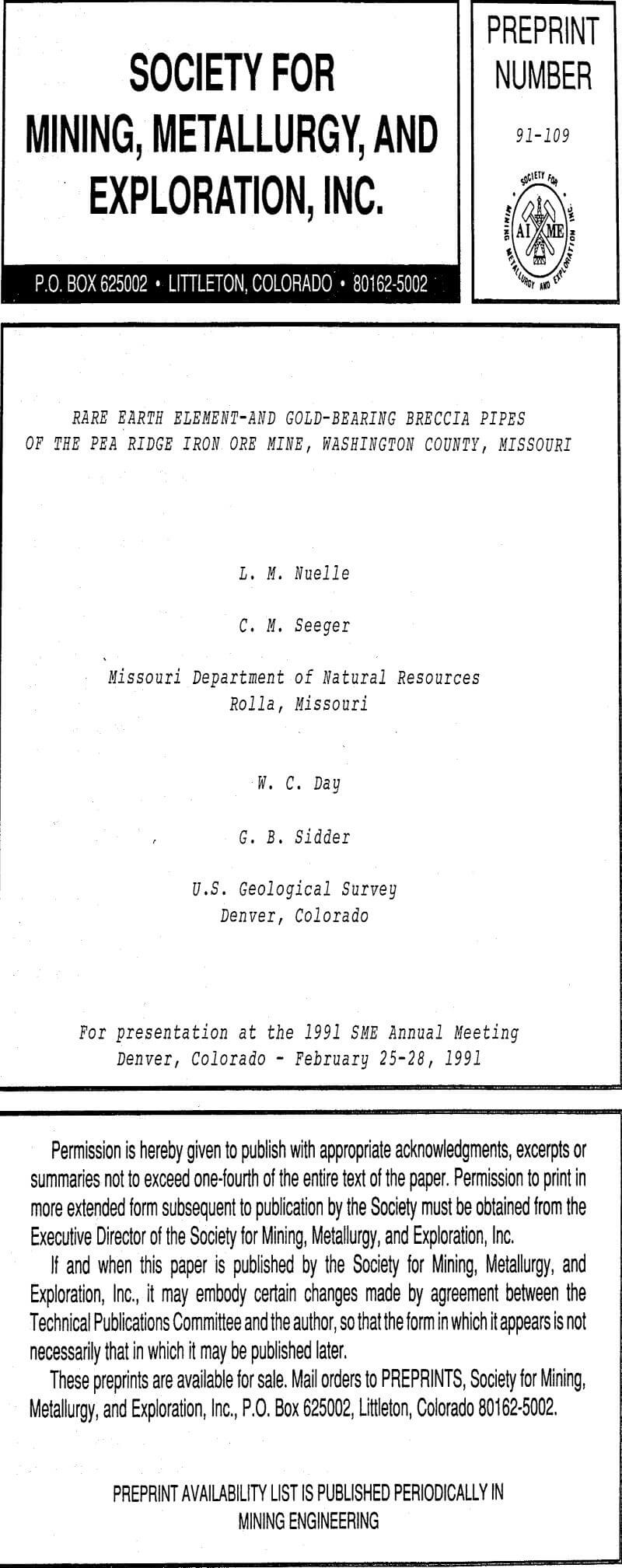Table of Contents
Rare earth element (REE)- and gold-bearing breccia pipes are a potentially significant economic target in the Pea Ridge iron ore mine, Washington County, Missouri. The Pea Ridge deposit is one of eight known volcanic-hosted iron ore deposits in the Middle Proterozoic St. Francois terrane, which are similar to the Olympic Dam-type deposits of Australia. Total REE oxide content of samples of the groundmass material, which are not diluted with lithic fragments, average about 20 weight percent. Grades from working faces in the mine are lower and average about 12 weight percent. Gold distribution is erratic, but concentrations are as high as 371 parts per million.
Geologic Setting
Middle Proterozoic rocks of the St. Francois terrane, which includes rhyolitic ash-flow tuffs, lava flows, and coeval granitic plutons, host Missouri’s Precambrian iron ore deposits. Zircons from the granites have yielded U-Pb isotopic ages of 1,480 to 1,450 Ma. The central plutons have distinct accessory minerals, such as fluorite, topaz, allanite, monazite, garnet, and cassiterite, and a characteristic trace element suite that includes elevated abundances of Sn, W, Nb, Y, Be, Li, Rb, Ba, and F. The central plutons have a unique negative magnetic anomaly signature.
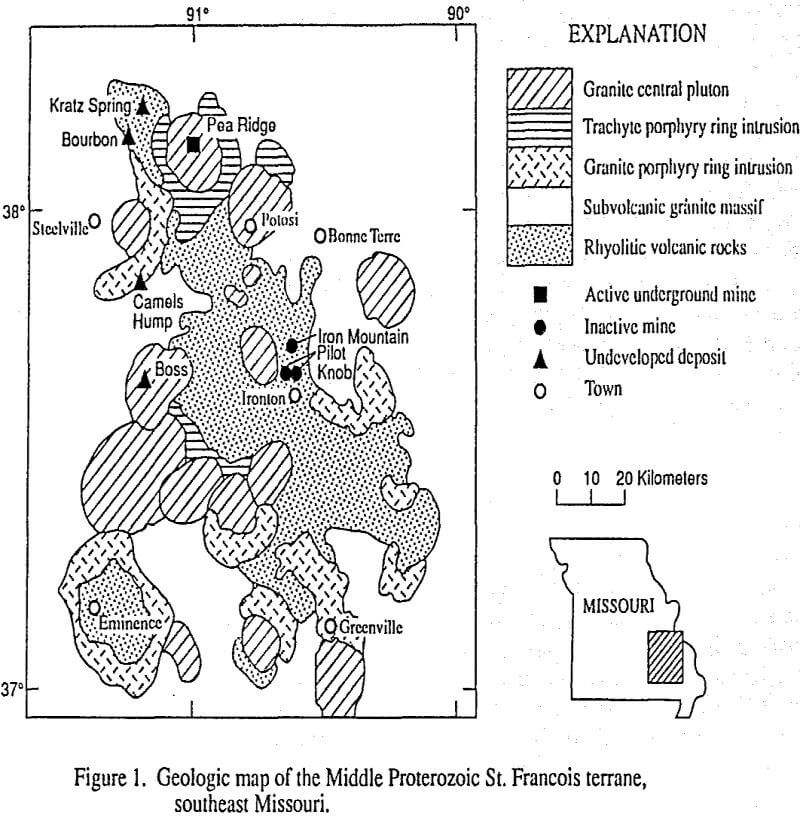
Geology of the Deposit
The amphibole-quartz zone occurs on both the hanging wall and footwall of the deposit. It consists of massive, coarse-grained actinolite (as much as 5 cm long) with interstitial apatite, magnetite, pyrite, chalcopyrite, and calcite. Quartz is present as both interstitial grains and as massive pods 1 to 50 cm in diameter.
The zone represents a skarn alteration front that preceded the emplacement of the magnetite orebody. The protolith of the amphibole-quartz zone was the host rhyolite. Metasomatic replacement of the protolith has partially destroyed obvious textural or chemical evidence of the original rock type.
Ore faces contain as much as 65 volume percent magnetite, with average grades ranging from 47 to 55 percent magnetic iron. The texture of the ore varies from massive and shiny with subconchoidal fracture to finely crystalline and granular. Some ore has a porphyritic texture in which magnetite (or martite after magnetite) and hematite megacrysts are in a massive fine-grained magnetite groundmass.
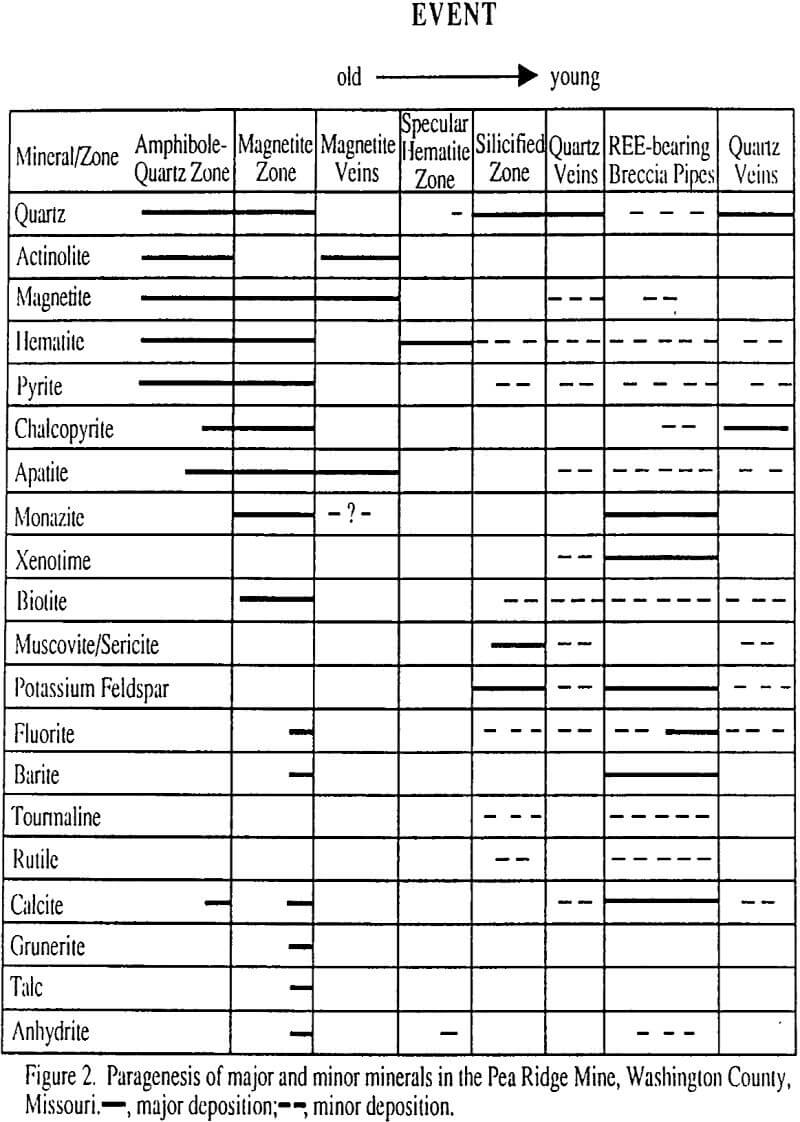
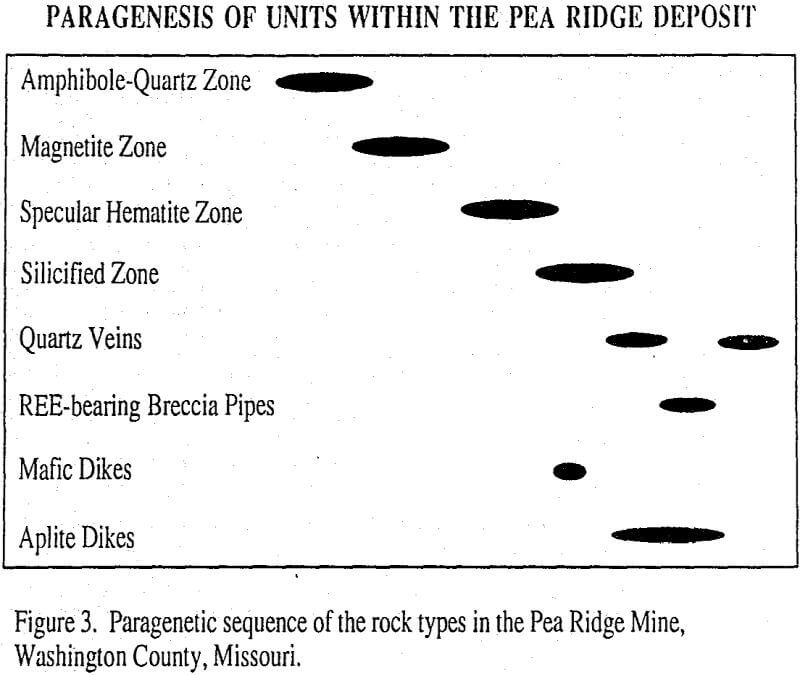
The heterolithic breccia was formed in a manner similar to an intrusion breccia. In situ exfoliation of wallrock fragments, in which magnetite filled the planes of the exfoliated sheets, and the presence, of wallrock schlieren suggest that the magnetite ore fluid had rheological properties similar to an intrusive magma.
The pseudobreccia has a sharp contact with the magnetite orebody. Along its outer margins, the pseudobreccia grades inward from iron oxide-cemented crackle breccia to iron oxide-cemented mosaic breccia, and then into rubble breccia near the magnetite orebody. Roundness and metasomatic alteration of the rhyolite fragments increases towards the orebody.
The specular hematite (specularite) zone separates the silicified zone from the magnetite orebody along the footwall, and rhyolite host rock from the orebody along the eastern edge of the deposit. The width of the zone varies, and it thins with depth. Contacts between the specular hematite zone and the magnetite orebody are commonly gradational, with irregularly distributed patches and areas of magnetite in the hematite. However locally, the contacts are sharp. The specularite is finely to coarsely crystalline, generally platy, compact, and massive. Most of the specularite is an alteration product of magnetite.
The silicified zone is a product of both open-space filling and replacement. The number of fractures increases from the wallrock into the silicified zone, which suggests that stockwork fracture systems may have controlled silicification. On the 2275-ft. level along the X-11 drift, silicification is associated with a high-angle fault. Sericite along fractures and fragment surfaces shows that sericitization accompanied silicification. T
Four REE-bearing breccia pipes have been delineated along the footwall and eastern edge of the 2275-ft. level of the orebody. The pipes occur at or near the contacts between the major lithologic zones. Contacts of the breccia pipes with rhyolite and silicified zone rocks are abrupt and commonly sheeted; those with the specular hematite zone are irregular and embayed. Locally, apophyses of breccia pipes protrude into adjacent rocks along fractures.
The pipes are steeply dipping (> 60°) and elongate to ovoid in plan view. They range in length from several meters to as much as 60 m and have widths as much as 15 m.
Geopetal structures within void spaces of the REE-bearing breccia pipe indicate that the magnetite deposit has not been tilted significantly since emplacement of the breccia pipes. One such structure on the 2440-ft. level is characterized by horizontally bedded, granulated rock particles that fill the bottom part of the void spaces and calcite that fills the upper part of the vug.
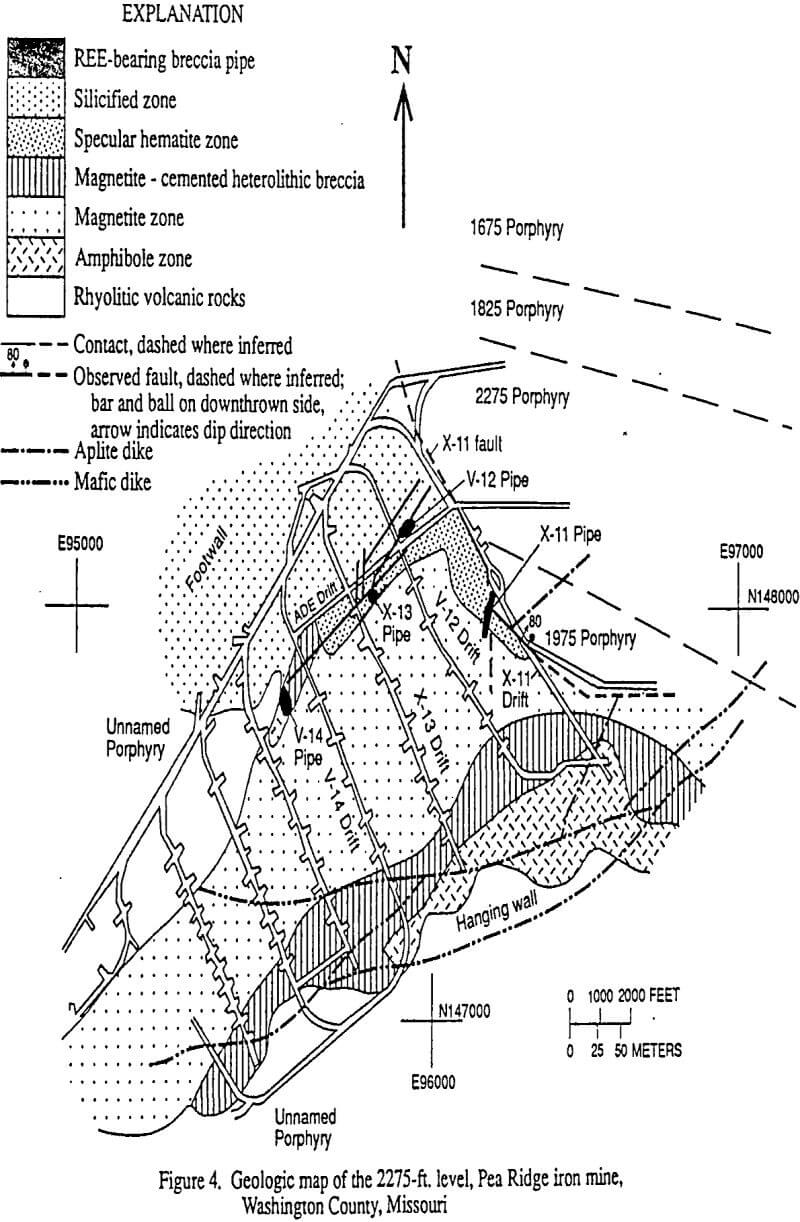
Swarms of barite and calcite veins and radioactive zones serve as exploration guides to blind pipes. Barite and calcite vein swarms and crackle breccias adjacent to pipes represent extensions of pipe mineralization. The radioactivity results from thorium and uranium associated with the REE-bearing minerals.
Genesis of the Rare Earth Element-Bearing Breccia Pipes
The REE-bearing breccia pipes are similar to magmatic-hydrothermal breccias related to porphyry-type deposits. However, they are not entirely analogous due to the disparity between the two types of ore systems (i.e., one is a high grade magnetite body whereas the other is a low-metal-content porphyry copper deposit). Nonetheless, the geochemical character and the intimate spatial relationship of the REE-bearing breccia pipes with the magnetite ore system implies a genetic link between the two.
Magmatic-hydrothermal breccias are commonly associated with subvolcanic ore deposits. The breccias are a result of fluids that exsolve from water-saturated magmas in subvolcanic or plutonic environments.
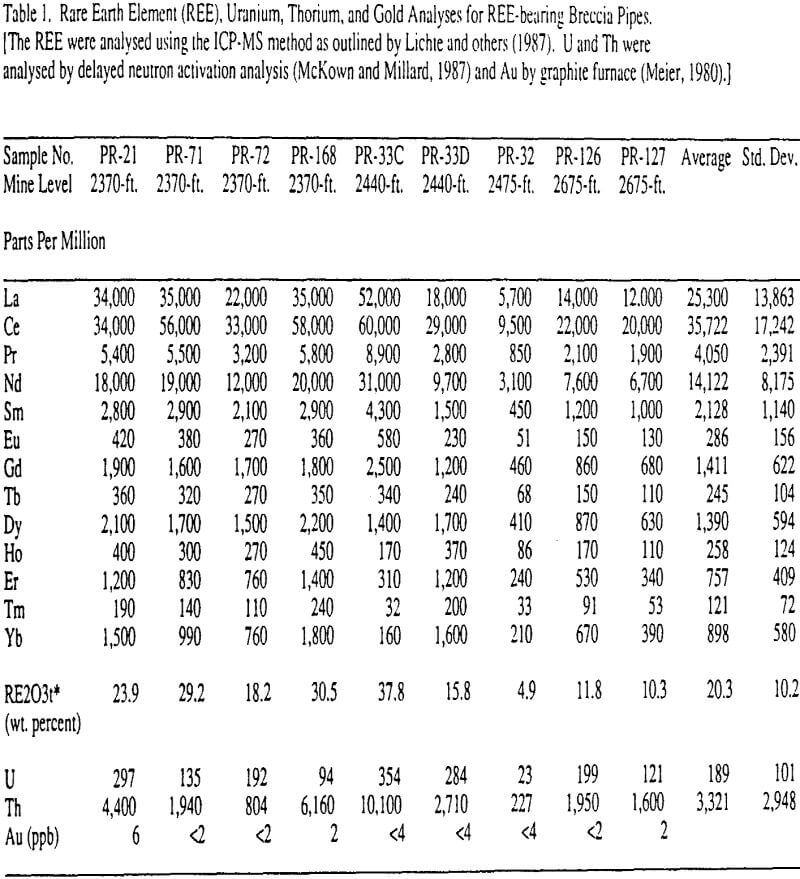
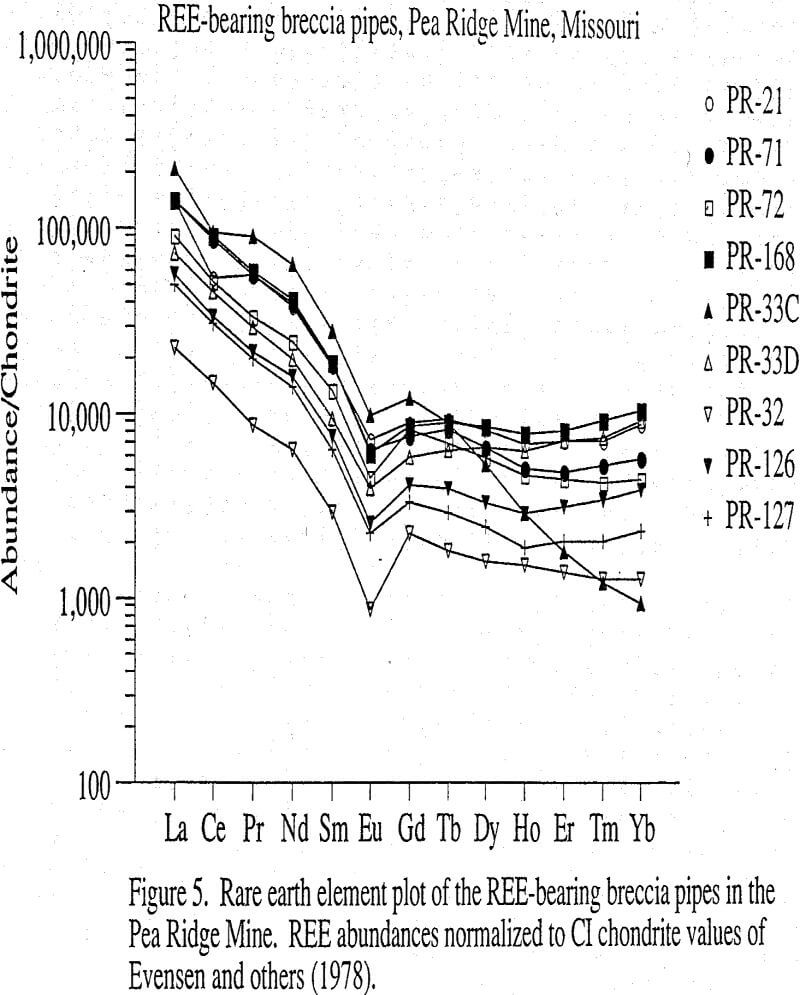
The Pea Ridge deposit is a tabular body of magnetite that stoped upward into the host rhyolitic wallrocks. Development of an amphibole-quartz skarn preceded magnetite deposition. The deposit is crudely zoned successively outward from a massive magnetite core to magnetite-cemented heterolithic breccia, to pseudobreccia, and to distal amphibole-quartz skarn. Other rock types include a specular hematite zone along the footwall and eastern edge of the orebody, massively silicified rock of the footwall, banded volcaniclastic rock, aplite dikes, and mafic dikes.
